Format Solid Gauge Dialog Box
You can use the Format Solid Gauge dialog box to format a solid gauge chart. This topic describes the options in the dialog box.
Designer displays the Format Solid Gauge dialog box when you right-click any range in an arc in a solid gauge chart and select Format Solid Gauge from the shortcut menu, or double-click any arc range in the solid gauge.
The dialog box contains the following tabs (Designer displays the Behaviors tab only when the chart is in a library component):
Designer displays these buttons in all the tabs:
OK
Select to apply your settings and close the dialog box.
Cancel
Select to close the dialog box without saving any changes.
Apply
Select to apply all changes and leave the dialog box open.
Help
Select to view information about the dialog box.
Circular Graph
Use this tab to specify properties of the arcs in the solid gauge.

Size
You can specify the size of the arcs in this box.
- Angle
Select the degree for the angle of the arcs. If you select "Customized", Designer displays the Customize Gauge Angle dialog box for you to customize the angle. - Thickness
Specify the thickness of the arcs, in pixels. - Hole Size
Specify the relative size of an arc in a percentage of the total arc size. - Start Style
Select the style for the start graph of the arcs: square, round, or long round. - End Style
Select the style for the end graph of the arcs: square, round, or long round.
Fill
You can specify the fill pattern of the arcs in this box.
- Color
Specify the color of the arcs. To edit the color, select the color indicator and select a color from the color palette, or type the hexadecimal RGB value of a color (for example, 0xff0000) in the text box. - Color List
Select to open the Color List dialog box to modify the color pattern for arcs in the same data series respectively. - Transparency
Specify the transparency of the arcs. - Self Settings
Select to apply the color pattern to the arcs themselves. When this option is cleared, Designer synchronizes the color pattern that you specify here with the Pattern List property of the chart in the Report Inspector, which data markers of other subtypes can also apply if the chart is a combo chart. - Background
Specify the background color of the arcs. - Use Range Color
Select to use the colors that you define for the ranges in the Range Color tab for the arcs.
Border
You can specify properties for the border of the arcs in this box.
- Color
Specify the color of the border. To edit the color, select the color indicator and select a color from the color palette, or type the hexadecimal RGB value of a color (for example, 0xff0000) in the text box. - Line Style
Select the line style of the border. - Transparency
Specify the transparency of the border. - Thickness
Specify the width of the border, in pixels. - End Caps
Select the ending style of the border.- butt
Select to end unclosed subpaths and dash segments with no added decoration. - round
Select to end unclosed subpaths and dash segments with a round decoration that has a radius equal to half of the line width. - square
Select to end unclosed subpaths and dash segments with a square projection that extends beyond the end of the segment to a distance equal to half of the line width.
- butt
- Line Joint
Select the joint style of the border.- miter
Select to join path segments by extending their outside edges until they meet. - round
Select to join path segments by rounding off the corner at a radius of half the line width. - bevel
Select to join path segments by connecting the outer corners of their wide outlines with a straight segment.
- miter
Sample
This box displays a preview sample based on your selections.
Axis Tab
Designer displays the following subtabs in the Axis tab:
Axis Subtab
Use this subtab to specify properties of the axis in the solid gauge.
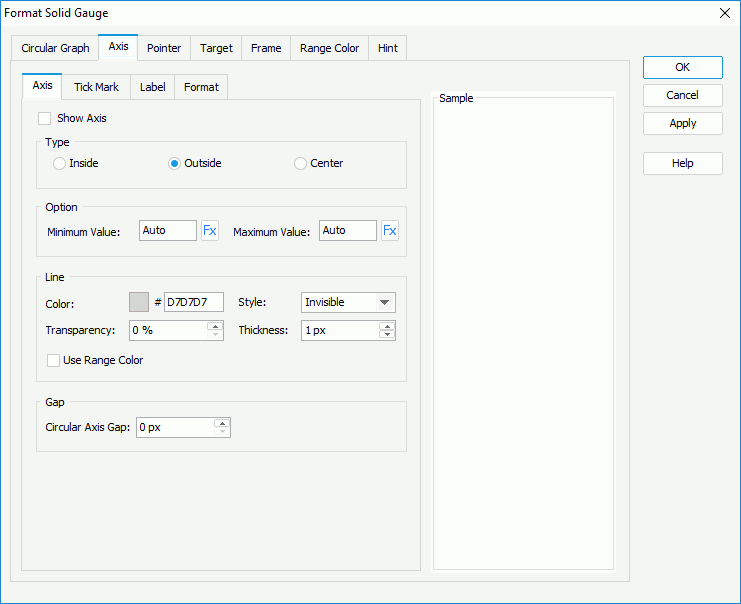
Show Axis
Select to show the axis in the solid gauge.
Type
You can specify the position relationship of the axis and the arcs in this box.
- Inside
Select to display the axis inside the arcs. - Outside
Select to display the axis outside the arcs. - Center
Select to display the axis in the center of the arcs.
You can specify the values to display on the axis in this box.
- Minimum Value
Specify the minimum value to display on the axis. You can select to use a formula to control the value.
to use a formula to control the value. - Maximum Value
Specify the maximum value to display on the axis. You can select to use a formula to control the value.
to use a formula to control the value.
You can specify properties of the axis line in this box.
- Color
Specify the color of the line. To edit the color, select the color indicator and select a color from the color palette, or type the hexadecimal RGB value of a color (for example, 0xff0000) in the text box. - Style
Select the style of the line. - Transparency
Specify the transparency of the line. - Thickness
Specify the thickness of the line. - Use Range Color
Select to use the colors that you define for the ranges in the Range Color tab for the line.
Gap
-
Circular Axis Gap
Specify the gap between the axis and the arc if the axis displays inside or outside the arcs.
Tick Mark Subtab
Use this subtab to specify properties of the tick marks on the axis.
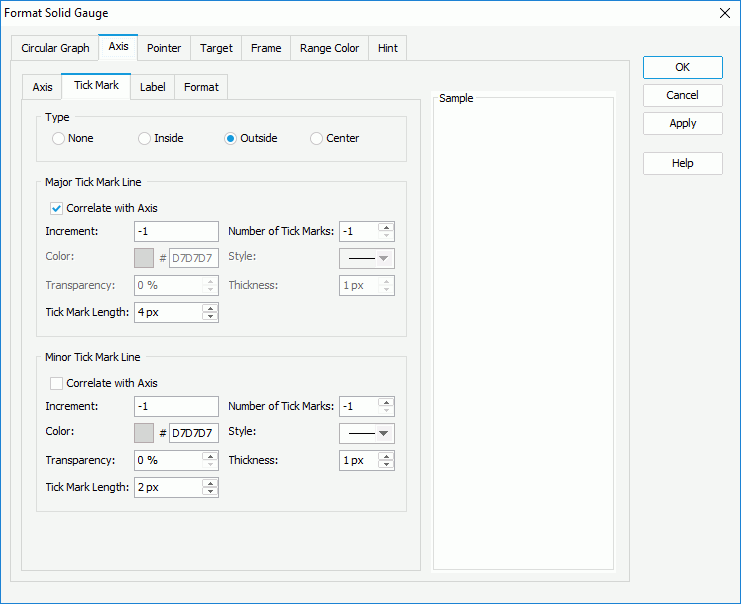
Type
You can specify the position relationship of the axis and the tick marks in this box.
- None
Select if you do not want to display tick marks on the axis. It is meaningless to specify all the other tick mark properties if you select this type. - Top
Select to display the tick marks on the top of the axis. - Bottom
Select to display the tick marks on the bottom of the axis. - Center
Select to display the tick marks in the center of the axis.
Major Tick Mark Line
You can specify the line properties of the major tick marks in this box.
- Correlate with Axis
Select to apply the line properties that you define for the axis in the Axis subtab to the major tick marks. When you clear this option, you can specify the line properties for the major tick marks separately using the following options:- Color
Specify the color of the major tick mark line. Designer disables this option when you select Use Range Color in the Axis subtab.To edit the color, select the color indicator and select a color from the color palette, or type the hexadecimal RGB value of a color (for example, 0xff0000) in the text box.
- Style
Select the style of the major tick mark line. - Transparency
Specify the transparency of the major tick mark line. Designer disables this option when you select Use Range Color in the Axis subtab. - Thickness
Specify the thickness of the major tick mark line.
- Color
- Increment
Specify the distance between two adjacent major tick marks on the axis. - Number of Tick Marks
Specify how many major tick marks you want to display on the axis. - Tick Mark Length
Specify the length of the major tick mark line.
Minor Tick Mark Line
You can specify properties of the minor tick marks in this box.
- Correlate with Axis
Select to apply the line properties that you define for the axis in the Axis subtab to the minor tick marks. When you clear this option, you can specify the line properties for the minor tick marks separately using the following options:- Color
Specify the color of the major tick mark line. Designer disables this option when you select Use Range Color in the Axis subtab.To edit the color, select the color indicator and select a color from the color palette, or type the hexadecimal RGB value of a color (for example, 0xff0000) in the text box.
- Style
Select the style of the minor tick mark line. - Transparency
Specify the transparency of the minor tick mark line. Designer disables this option when you select Use Range Color in the Axis subtab. - Thickness
Specify the thickness of the minor tick mark line.
- Color
- Increment
Specify the distance between two adjacent minor tick marks on the axis. - Number of Tick Marks
Specify how many minor tick marks you want to display on the axis. - Tick Mark Length
Specify the length of the minor tick mark line.
Sample
This box displays a preview sample based on your selections.
Label Subtab
Use this subtab to specify properties of the major tick mark labels.
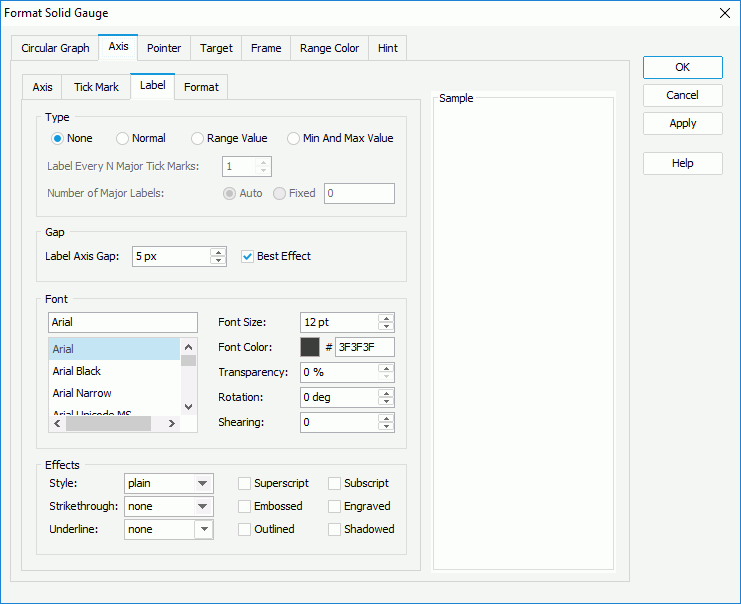
Type
You can specify in which manner to display the major tick mark labels in this box.
- None
Select if you do not want to display labels for the major tick marks. - Normal
Select it and you can specify how to display the labels using the following options:- Label Every N Major Tick Marks
Specify the frequency at which to label the major tick marks. - Number of Major Labels
Specify how many major tick mark labels you want to display on the axis.- Auto
Select to display all the major tick mark labels. - Fixed
Select it and you can specify the number of the major tick mark labels you want to display on the axis.
- Auto
- Label Every N Major Tick Marks
- Range Value
Select to show the range values that you define in the Range Color tab as the labels. - Min and Max Values
Select to show the minimum value and maximum value that you define in the Axis subtab as the labels.
Gap
You can specify the gap properties for the major tick mark labels in this box.
- Label Axis Gap
Specify the distance between the labels and the axis, in pixels. - Best Effect
Select to adjust the labels automatically to place them in the best position. When you select this option, Designer hides some labels if they overlap.
Font
You can specify the font style of the text in the major tick mark labels in this box.
- Font list
This drop-down list contains all the font faces you can select to apply to the text. - Font Size
Specify the font size of the text. - Font Color
Specify the font color of the text. To edit the color, select the color indicator and select a color from the color palette, or type the hexadecimal RGB value of a color (for example, 0xff0000) in the text box. - Transparency
Specify the transparency of the text. - Rotation
Specify the rotation angle of the text around its center, in degrees. The default value is 0. - Shearing
Specify the gradient of the text.
![]() Designer disables the Font Color and Transparency options if you select Use Range Color in the Axis subtab.
Designer disables the Font Color and Transparency options if you select Use Range Color in the Axis subtab.
Effects
You can specify the special effects of the text in the tick mark labels in this box.
- Style
Select the font style of the text. It can be one of the following: plain, bold, italic, and bold italic. - Strikethrough
Select the style of the horizontal line using which to strikethrough the text. It can be one of the following: none, thin line, bold line, and double lines. - Underline
Select the style of the horizontal line under the text. It can be one of the following: none, single, single lower, bold line, bold lower, double lines, bold double, patterned line, and bold patterned. When you select "patterned line" or "bold patterned", Designer draws a line or bold line in the pattern of the text. - Superscript
Select to raise the text above the baseline and change the text to a smaller font size, if a smaller size is available. - Subscript
Select to lower the text below the baseline and change the text to a smaller font size, if a smaller size is available. - Embossed
Select to make the text appear to be raised off the page in relief. - Engraved
Select to make the text appear to be imprinted or pressed into the page. - Outlined
Select to display the exterior border around each character of the text. - Shadowed
Select to add a shadow beneath and to the right of the text.
![]() Web Report Studio and JDashboard do not support underlining chart text, therefore, this property is ignored when the chart runs in Web Report Studio or is used in a dashboard.
Web Report Studio and JDashboard do not support underlining chart text, therefore, this property is ignored when the chart runs in Web Report Studio or is used in a dashboard.
Sample
This box displays a preview sample based on your selections.
Format Subtab
Use this subtab to specify the data format of the major tick mark labels.

Category & Format
These two boxes list the category types and the formats of each category that Designer provides by default. Select a category and a format for this category, then select Add to add it as the format of the category. You can add only one format for each category.
Properties
This text box shows the properties of the format that you select in the Format box. If the default formats Designer provides for a category cannot meet your requirement, you can define your own format in the text box and select Add to add it as the format of the category.
Auto Scale in Number
Specify whether to automatically scale the Number values that fall into the two ranges:
- When 1000 <= value < 10^15, Designer applies the following quantity unit symbols of the International System of Units to scale the values: K (10^3), M (10^6), G (10^9), and T (10^12).
- When 0 < value < 0.001 or value >= 10^15, Designer uses scientific notation to scale the values.
By default, Designer selects "auto" for the option, meaning, Designer applies the setting that you specify for the same property on the chart in the Report Inspector for the values. If you select "true", Designer applies the specified format to the integer part of the values after scaling them; however, if the specified format conflicts with the logic of Auto Scale in Number, for example, the values display in percentage, Designer ignores the Auto Scale in Number setting. Select "false" if you do not want to scale the values.
Sample
This box displays a sample for the selected format.
Stack
This box lists all the formats that you select from different categories.
Add
Select to add a format to the Stack box.
Remove
Select to remove the specified format from the Stack box.
Apply
Select to apply the specified format to the major tick mark labels.
Pointer Tab
Use this tab to specify properties of the pointers in the solid gauge.
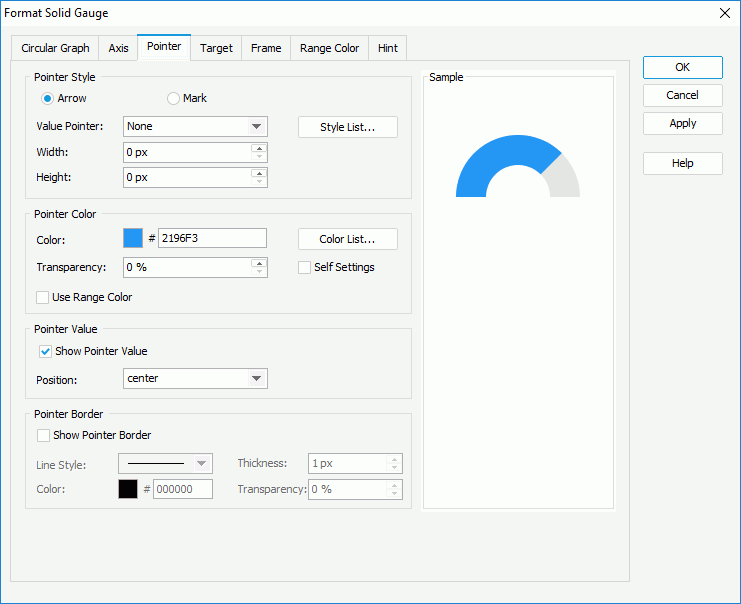
Pointer Style
You can specify the style of the pointers in this box.
- Arrow
Select to use arrow for the pointers.- Value Pointer
Select the style of the arrow. You can select "Customized" from the drop-down list to specify an image as the pointer. - Width
Specify the width of the arrow. - Height
Specify the height of the arrow.
- Value Pointer
- Mark
Select to use mark for the pointers.- Value Pointer
Select the style of the mark. You can select "Customized" from the drop-down list to specify an image as the pointer. - Width
Specify the width of the mark. - Height
Specify the height of the mark. - Position
Select the position of the pointers relative to the arcs: top, bottom, or center. - Gap
Specify the distance between the pointers and the arcs, in pixels.
- Value Pointer
- Style List
Select to open the Style List dialog box to specify the style for pointers in the same data series respectively.
Pointer Color
You can specify the color pattern of the pointers in this box.
- Color
Specify the color of the pointers. To edit the color, select the color indicator and select a color from the color palette, or type the hexadecimal RGB value of a color (for example, 0xff0000) in the text box. - Color List
Select to open the Color List dialog box to modify the color pattern for pointers in the same data series respectively. - Transparency
Specify the transparency of the pointers. - Self Settings
Select to apply the color pattern to the pointers themselves. When this option is cleared, Designer synchronizes the color pattern that you specify here with the Pattern List property of the chart in the Report Inspector, which data markers of other subtypes can also apply if the chart is a combo chart. - Use Range Color
Select to use the colors that you define for the ranges in the Range Color tab for the pointers.
Pointer Value
You can specify properties of the pointer values in this box.
- Show Pointer Value
Select to show values for the pointers. - Position
Select the position of the values relative to the pointers: top, bottom, center, on pointer, or customized. If you select "customized", you can customize the position by dragging any pointer value in the design area.
Pointer Border
You can specify properties for the border of the pointers in this box.
- Show Pointer Border
Select to show the border of the pointers. - Color
Specify the color of the border. To edit the color, select the color indicator and select a color from the color palette, or type the hexadecimal RGB value of a color (for example, 0xff0000) in the text box. - Line Style
Select the line style of the border. - Transparency
Specify the transparency of the border. - Thickness
Specify the width of the border, in pixels.
Sample
This box displays a preview sample based on your selections.
Target Tab
Use this tab to specify properties of the target in the solid gauge.

Use Target Value
Select to use target value for the solid gauge.
- Target Value
Specify the target value. You can select to use a formula to control the value.
to use a formula to control the value.
Pointer Style
You can specify the pointer style for the target value in this box.
- Target Pointer
Select the style of the target pointer. You can select "Customized" from the drop-down list to specify an image as the target pointer. - Width
Specify the width of the target pointer. - Height
Specify the height of the target pointer. - Position
Select the position of the target pointer relative to the arcs: top, bottom, or center. - Gap
Specify the distance between the target pointer and the arcs.
Pointer Color
You can specify the color pattern of the target pointer in this box.
- Color
Specify the color of the target pointer. To edit the color, select the color indicator and select a color from the color palette, or type the hexadecimal RGB value of a color (for example, 0xff0000) in the text box. - Transparency
Specify the transparency of the target pointer.
Target Value
You can specify properties of the target value in this box.
- Show Target Value
Select to show the target value on the solid gauge. - Position
Select the position of the target value relative to the arcs: top, bottom, center, on pointer, or customized. If you select "customized", you can customize the position by dragging the target value in the design area.
Sample
This box displays a preview sample based on your selections.
Frame Tab
Use this tab to specify properties for the frame of the solid gauge.
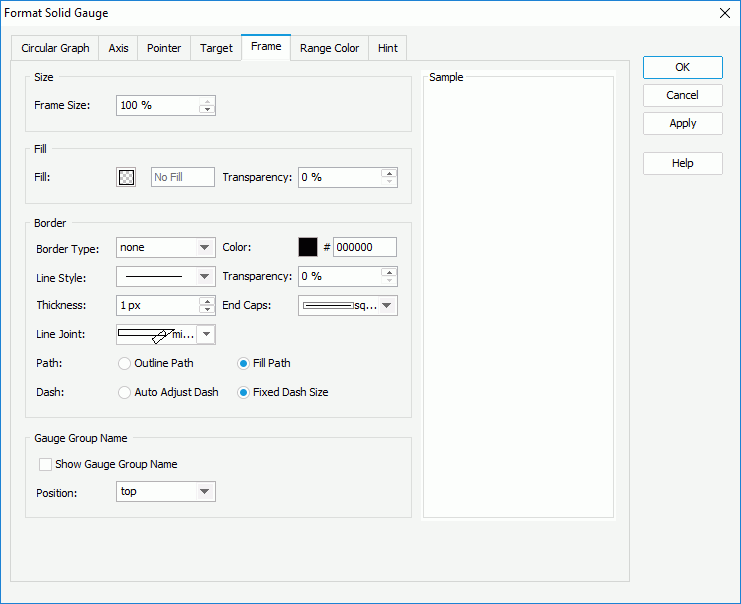
Size
You can specify the frame size in this box.
- Frame Size
Specify the size of the frame.
Fill
You can specify the fill pattern of the frame in this box.
- Fill
Specify the fill pattern of the frame. To edit the fill pattern, select the color indicator and specify a color or effect using the color palette. You can also type the hexadecimal RGB value of a color (for example, 0xff0000) in the text box. - Transparency
Specify the transparency of the fill pattern.
Border
You can specify properties for the border of the frame in this box.
- Border Type
Select the type of the border.- none
Select if you do not want to show the border. - raised
Select to show 3-D border that appears as if it is raised off the page. - recess
Select to show 3-D border that appears as if it is pressed into the page. - shadow
Select to show two shadowed borders, beneath and to the right of the object. - solid
Select to use single-line border.
- none
- Color
Specify the color of the border. To edit the color, select the color indicator and select a color from the color palette, or type the hexadecimal RGB value of a color (for example, 0xff0000) in the text box. - Line Style
Select the line style of the border. - Transparency
Specify the transparency of the border. - Thickness
Specify the width of the border, in pixels. - End Caps
Select the ending style of the border.- butt
Select to end unclosed subpaths and dash segments with no added decoration. - round
Select to end unclosed subpaths and dash segments with a round decoration that has a radius equal to half of the line width. - square
Select to end unclosed subpaths and dash segments with a square projection that extends beyond the end of the segment to a distance equal to half of the line width.
- butt
- Line Joint
Select the joint style of the border.- miter
Select to join path segments by extending their outside edges until they meet. - round
Select to join path segments by rounding off the corner at a radius of half the line width. - bevel
Select to join path segments by connecting the outer corners of their wide outlines with a straight segment.
- miter
- Path
Specify the fill pattern of the border.- Outline Path
Select to use outline path for the border. - Fill Path
Select to use whole path for the border.
- Outline Path
- Dash
Specify the dash size of the border if you select a dash line style for the border.- Auto Adjust Dash
Select to adjust the dash size automatically. - Fixed Dash Size
Select to use fixed dash size.
- Auto Adjust Dash
Gauge Group Name
You can specify options for the gauge group names in this box.
- Show Gauge Group Name
Select to show names for the arcs in the solid gauge which are values of the field on the category axis. If the solid gauge contains no category field, the group name shows "Report" by default. - Position
Select the position of the names relative to the arcs: top, bottom, center, or customized. If you select "customized", you can customize the position by dragging any name in the design area.
Sample
This box displays a preview sample based on your selections.
Range Color Tab
Use this tab to specify the value ranges for the solid gauge and the color and name of each range.
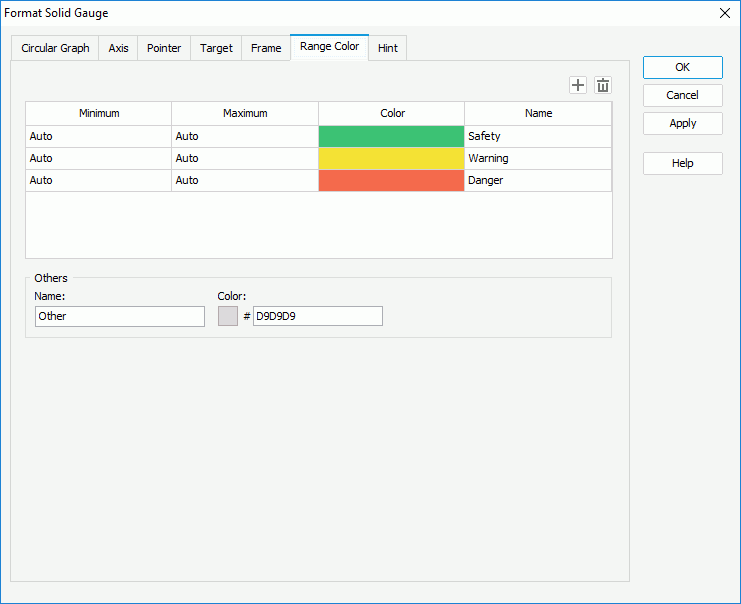
 Add button
Add button
Select to add a new range.
 Remove button
Remove button
Select to delete the specified range.
Minimum
This column shows the minimum values that you specify for the ranges.
Maximum
This column shows the maximum values that you specify for the ranges.
Color
This column shows the colors that you specify for the ranges. To edit the color, select in the cell and customize the color in the color palette.
Name
This column shows the names that you specify for the ranges.
Others
You can specify the properties for values that do not fall into any of the ranges you define in this box.
- Name
Specify the name for the values. - Color
Specify the color for the values. To edit the color, select the color indicator and select a color from the color palette, or type the hexadecimal RGB value of a color (for example, 0xff0000) in the text box.
Hint Tab
Use this tab to specify properties for the hint of the solid gauge.
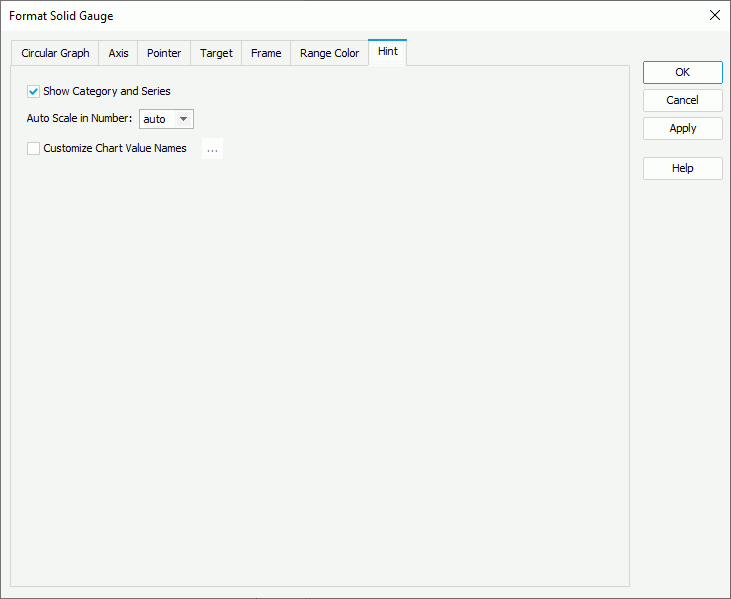
Show Category and Series
Select to include the category and series values in the hint.
Auto Scale in Number
Specify whether to automatically scale the Number values in the hint that fall into the two ranges:
- When 1000 <= value < 10^15, Designer applies the following quantity unit symbols of the International System of Units to scale the values: K (10^3), M (10^6), G (10^9), and T (10^12).
- When 0 < value < 0.001 or value >= 10^15, Designer uses scientific notation to scale the values.
By default, Designer selects "auto" for the option, meaning, Designer applies the setting that you specify for the same property on the chart in the Report Inspector for the values. If you select "true", Designer applies the specified format to the integer part of the values after scaling them; however, if the specified format conflicts with the logic of Auto Scale in Number, for example, the values display in percentage, Designer ignores the Auto Scale in Number setting. Select "false" if you do not want to scale the values.
Customize Chart Value Names
Select to customize the names of the fields on the value axis which you want to display in the hint. By default, Designer applies the display names of the fields in the hint to label the values which may be not intuitive to users. You can select the option and select the ellipsis  to customize the names in the Customize Chart Value Names dialog box to help users better understand the values.
to customize the names in the Customize Chart Value Names dialog box to help users better understand the values.
Behaviors Tab
Designer displays the Behaviors tab only when the solid gauge chart is in a library component. You can use it to specify web behaviors to the solid gauge.

 Add button
Add button
Select to add a new web behavior line.
 Remove button
Remove button
Select to delete the specified web behavior.
 Move Up button
Move Up button
Select to move the specified web behavior higher in the list. At runtime, when an event bound with more than one action happens, JDashboard triggers the upper action first.
 Move Down button
Move Down button
Select to move the specified web behavior lower in the list.
Events
This column shows the events that you select to trigger the web actions.
Actions
This column shows the web actions that you specify for the events to trigger. Select the ellipsis  in each cell to bind the web action using the Web Action List dialog box.
in each cell to bind the web action using the Web Action List dialog box.
 Previous Topic
Previous Topic
 Back to top
Back to top